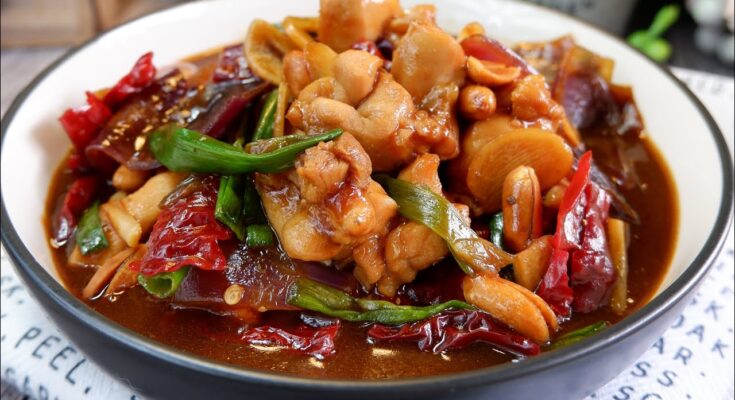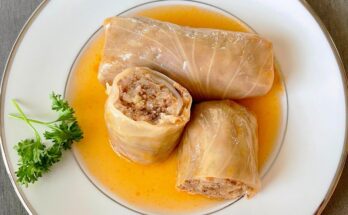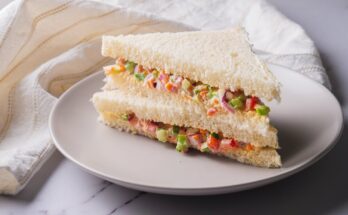Kung Pao Chicken Recipe: Kung Pao Chicken is a classic Chinese dish originating from the Sichuan province. Known for its spicy, tangy, and slightly sweet flavors, it’s a stir-fried delicacy featuring chicken, peanuts, and vegetables in a savory sauce. The dish is beloved worldwide for its bold flavors and satisfying crunch.
The History Behind Kung Pao Chicken
Kung Pao Chicken, or “Gong Bao Ji Ding,” is named after Ding Baozhen, a Qing Dynasty governor of Sichuan. Over time, it evolved from a traditional Chinese recipe into a globally popular dish, adapted to suit diverse palates.
Why You’ll Love This Recipe
This Kung Pao Chicken recipe is easy to follow, incredibly versatile, and delivers restaurant-quality results at home. Whether you’re a seasoned cook or a beginner, you’ll enjoy mastering this dish. Plus, it’s customizable, allowing you to adjust the heat level and add your favorite vegetables.
Ingredients for Kung Pao Chicken
Essential Ingredients
- Chicken: Boneless, skinless chicken thighs or breasts (500g).
- Vegetables: Diced bell peppers, onions, and green onions.
- Peanuts: Roasted, unsalted peanuts for crunch.
- Kung Pao Sauce: Soy sauce, dark soy sauce, rice vinegar, hoisin sauce, sugar, and cornstarch.
- Sichuan Peppercorns: For authentic numbing heat.
- Dried Red Chilies: Adds a smoky, spicy flavor.
Optional Add-Ons for Personalization
- Cashews as a peanut alternative.
- Additional vegetables like zucchini, carrots, or broccoli.
- A drizzle of sesame oil for a nutty aroma.
Ingredient Substitutions
- Swap chicken with tofu for a vegetarian version.
- Use tamari for a gluten-free option.
- Replace Sichuan peppercorns with black pepper if unavailable.
Equipment You’ll Need
Basic Kitchen Tools
- A sharp chef’s knife for precise cutting.
- Cutting board to prep ingredients.
- Mixing bowls for marinating and sauce preparation.
Specialty Equipment for Authentic Flavor
- Wok: The best tool for stir-frying.
- Mortar and Pestle: To grind Sichuan peppercorns.
- Spider Strainer: Ideal for scooping ingredients quickly.
Preparing the Ingredients
Cutting and Marinating the Chicken
- Dice chicken into bite-sized pieces.
- In a bowl, mix soy sauce, cornstarch, and a dash of rice vinegar.
- Marinate the chicken for 20–30 minutes to infuse flavor and tenderize the meat.
Prepping Vegetables and Nuts
- Dice bell peppers and onions into uniform pieces for even cooking.
- Roast peanuts in a dry pan for enhanced crunchiness, if not pre-roasted.
Creating the Kung Pao Sauce
In a small bowl, whisk together:
- 2 tbsp soy sauce
- 1 tbsp dark soy sauce
- 1 tbsp rice vinegar
- 1 tbsp hoisin sauce
- 1 tsp sugar
- 1 tsp cornstarch
Adjust the sugar or vinegar to balance the sweet and tangy elements.
Cooking Instructions
Stir-Frying the Chicken
- Heat 2 tbsp of oil in a wok over medium-high heat.
- Add marinated chicken and stir-fry until golden brown and cooked through. Remove and set aside.
Cooking the Vegetables
- In the same wok, heat a little more oil.
- Toss in Sichuan peppercorns and dried chilies for a few seconds until aromatic.
- Add diced vegetables and stir-fry for 3–4 minutes, ensuring they retain some crunch.
Combining Everything
- Return the chicken to the wok, mixing it with the vegetables.
- Pour the prepared Kung Pao sauce over the mixture, stirring until everything is evenly coated and the sauce thickens.
- Toss in roasted peanuts, mixing well before serving.
Tips for Perfect Kung Pao Chicken
Achieving the Right Flavor Balance
Kung Pao Chicken is all about the perfect harmony of spicy, tangy, and slightly sweet flavors. To achieve this:
- Adjust the level of dried chilies based on your spice tolerance.
- Use rice vinegar for a subtle tang, and balance it with sugar.
- Don’t skip the Sichuan peppercorns—they add the signature numbing sensation.
Getting the Ideal Texture
- Marinating the chicken with cornstarch ensures a silky, tender texture.
- Stir-fry over high heat to keep the chicken juicy and vegetables crisp.
- Use fresh peanuts or cashews for an added crunch.
Common Mistakes to Avoid
- Avoid overcooking the chicken; it can become dry.
- Don’t overcrowd the wok, as it may cause steaming rather than frying.
- Be cautious with salt—soy sauce and hoisin sauce already contain sodium.
Serving Suggestions
Side Dishes That Pair Well
- Steamed Rice: A classic companion that soaks up the flavorful sauce.
- Fried Rice: For a heartier meal, pair with egg-fried rice or vegetable fried rice.
- Noodles: Kung Pao Chicken goes perfectly with plain or stir-fried noodles.
Garnishing Ideas
- Sprinkle with chopped green onions for freshness.
- Add a handful of sesame seeds for a nutty aroma.
- Drizzle with a touch of chili oil for extra spice and color.
Variations of Kung Pao Chicken
Vegetarian Kung Pao
Replace chicken with firm tofu or tempeh. Stir-fry it the same way, ensuring the tofu is crispy on the outside while soft inside.
Low-Calorie Version
- Use less oil for stir-frying.
- Replace sugar with a natural sweetener like honey or stevia.
- Incorporate more vegetables like zucchini, carrots, or snap peas to bulk up the dish.
Gluten-Free Option
- Substitute soy sauce with tamari or coconut aminos.
- Ensure the hoisin sauce is gluten-free.
- Check that all other ingredients, like vinegar and cornstarch, are free of gluten.
Storing and Reheating Tips
Best Practices for Refrigeration
- Store leftovers in an airtight container.
- Refrigerate within 2 hours of cooking to maintain freshness.
- Consume within 3 days for the best taste and texture.
Freezing Kung Pao Chicken
- Portion the dish into freezer-safe containers.
- Label with the date, and store for up to 3 months.
- Thaw in the refrigerator overnight before reheating.
Reheating Without Losing Flavor
- Reheat in a wok or frying pan over medium heat, adding a splash of water or broth to revive the sauce.
- Avoid microwaving, as it can make the chicken rubbery.
Nutritional Information
Calorie Count
A typical serving of Kung Pao Chicken contains approximately 300–400 calories, depending on portion size and added ingredients.
Nutritional Benefits of Ingredients
- Chicken: A lean protein source.
- Peanuts: High in healthy fats and protein.
- Bell Peppers: Rich in vitamins A and C.
- Sichuan Peppercorns: Known for digestive benefits and unique flavor.
FAQs about Kung Pao Chicken Recipe
1. What is Kung Pao Chicken?
Kung Pao Chicken is a popular Chinese dish known for its spicy and savory flavors. It typically consists of diced chicken, peanuts, vegetables, and chili peppers stir-fried in a rich sauce made from soy sauce, hoisin sauce, and Szechuan peppercorns.
2. Is Kung Pao Chicken very spicy?
The spice level of Kung Pao Chicken can vary. Traditionally, it is quite spicy due to the use of chili peppers and Szechuan peppercorns. However, you can adjust the amount of these ingredients to suit your taste preferences.
3. Can I make Kung Pao Chicken without nuts?
Yes, you can make Kung Pao Chicken without nuts. While peanuts are a common ingredient, they can be omitted or substituted with seeds like sunflower or pumpkin seeds for a nut-free version of the dish.
4. What vegetables are typically included in Kung Pao Chicken?
Common vegetables in Kung Pao Chicken include bell peppers, zucchini, and onions. Some recipes also incorporate broccoli, snow peas, or carrots to add color and nutrition.
5. How can I make a vegetarian version of Kung Pao Chicken?
To make a vegetarian Kung Pao, replace the chicken with tofu or a plant-based protein. Ensure to press the tofu to remove excess water and pan-fry until crispy for the best texture.
6. What should I serve with Kung Pao Chicken?
Kung Pao Chicken is traditionally served with steamed rice or noodles. For a low-carb option, you can serve it with cauliflower rice or alongside a fresh green salad.
7. How long does it take to prepare Kung Pao Chicken?
Preparation time can vary, but typically, Kung Pao Chicken takes about 20 to 30 minutes to prepare and cook. It’s a great option for a quick and flavorful weeknight dinner.
8. Can I store and reheat Kung Pao Chicken?
Yes, Kung Pao Chicken can be stored in the refrigerator for up to three days. Reheat it in a skillet over medium heat or in the microwave for best results. Avoid overheating to prevent the vegetables from becoming too soft.
Conclusion
Kung Pao Chicken is more than just a dish—it’s a flavorful journey through Chinese cuisine. Its balance of spicy, savory, and sweet flavors makes it a timeless favorite that you can easily recreate at home. Whether you’re hosting a dinner party or whipping up a quick weeknight meal, this recipe is a guaranteed hit. Give it a try and bring a taste of Sichuan to your kitchen!



